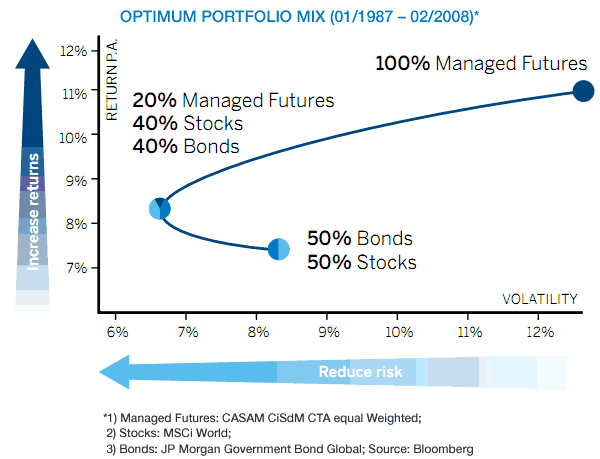Overlaying Strategies in Managed Futures Does it Help an Investor
Post on: 31 Март, 2015 No Comment

By Mark Shore
I was recently interviewed for a few articles and the topic of overlaying strategies was discussed as a potential component of a managed futures portfolio. Realizing this topic is not discussed as much as it should be; it opens the door to a more in-depth understanding of managed futures. It is a topic I cover in my managed futures course at DePaul University.
Discussing this topic of overlaying strategies really gets to the heart of one question that keeps reappearing, “why are CTAs non-correlated to equities?” This is a very simple question to ask and is asked with high frequency. But the answer includes many topics to properly answer it. As Matt Davio recently stated, it’s the “special sauce” in understanding managed futures. One of the topics of the special sauce is the utilization of overlaying strategies.
For example, let’s assume the following of a fictional CTA (Commodity Trading Advisor):
- The CTA trades a diversified systematic trend following model (Core model) in 20 markets in both financial and commodity futures.
- The model can be long, short or neutral in any of the 20 markets of its portfolio. (Neutral means the portfolio does not hold any positions in a particular market.)
- The size of each position is not static, but may be dynamic based on some formula built into the trading algorithm. For example: our fictional CTA may trade a 20 contract position in 30 year bond futures. On the next trade in that market, they may hold more or less contracts based on their trading strategy.
- Stops and other risk management tools may be used utilized for risk management purposes
The above assumptions imply the portfolio at any given time could hold positions in zero to 20 markets. And due to the dynamic nature of being long, short or neutral and the utilization of various risk management methods the portfolio may be very fluid causing changes in the portfolio due to the strategy components. Thus the equity curve of the portfolio creates a non-correlation potential to equities.
Now that we have conquered the understanding of the Core model, let’s move forward in time and assume the CTA now allocates within their fund to a few other trading systems that may involve longer or shorter time frames or some other variations.
Perhaps the CTA allocates 70%, 80% or 90% to the Core model and allocates (or overlays) the balance of the fund to the other systems. The logic of overlaying other systems is to smooth out the returns of the Core model. By overlaying various systems into one fund, the CTA has in essence organically created a quasi Fund of Fund.
The investor as well as the CTA has to ask: Does the overlay smooth the returns? Does it reduce volatility? Or asked another way, does it reduce the negative volatility (tail risk)? Keep in mind there is a difference between positive and negative volatility. We will leave the discussion of parsing volatility for another time.
By allocating to multiple systems it potentially maintains a fluid and/ or dynamic portfolio, thus equating to potential tendencies for non-correlation to equities. From the CTAs perspective they are not only managing a portfolio of futures markets, but they are also managing a portfolio of portfolios. One may call it a second derivative of the portfolio.
In times of economic stress, nervous investors tend to run for the exit door simultaneously causing the correlations of many sectors and asset classes to increase. 2008 is great example of investors running for the exit door. If a manager is trading multiple markets from a long, short or neutral perspective and potentially overlaying strategies; could this investment be non-correlated to equities?
In summary, not all CTAs overlay trading systems into a fund or portfolio, thus one more reason why CTAs differ (see Decoding the Myths of Managed Futures). This is not a judgment call of a good or bad idea of risk management. But simply as part of the due diligence process, the investor should know if the CTA is overlaying systems, to understand the concepts of those systems and the source of returns of the fund and how the overlay may offer another potential method of non-correlation to equities. Understanding this topic gives an investor a deeper understanding of the managed futures industry.
Ultimately the investor has to determine if the investment adds value to their current portfolio.
Mark Shore publishes research, consults on alternative investments and conducts educational workshops. Mark Shore is also an Adjunct Professor at DePaul University’s Kellstadt Graduate School of Business in Chicago where he teaches a managed futures/ global macro course.














